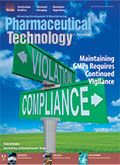Responding to FDA CAPA Requests (2018)
Pharmaceutical Technology spoke with Sharon Ayd, executive vice-president of Pre-approval Pharmaceuticals and chief scientific officer at Regulatory Compliance Associates, about developing a corrective action and preventive action (CAPA) plan.
Pharmaceutical Technology spoke with Sharon Ayd, executive vice-president of Pre-approval Pharmaceuticals and chief scientific officer at Regulatory Compliance Associates, about developing a corrective action and preventive action (CAPA) plan.
PharmTech: What are the best practices for developing a detailed CAPA?
Ayd: A CAPA program requires a well-documented system that determines the root cause of nonconformances, system failures, or process problems, corrects them, and prevents them from recurring. A corrective action is a reaction to a situation that has occurred and is intended to fix the problem or modify the quality system so that reoccurrence is prevented. The result is a complete documented investigation/solution that meets regulatory requirements and is the basis for effective continuous improvement. A preventive action is initiated to stop a problem from occurring. It assumes that monitoring and controls are in place to assure problems are identified and eliminated before they happen. If the quality system indicates a problem may develop, a preventive action should be implemented to avert the situation.
PharmTech: A variety of recent FDA warning letters have cited companies for not providing the agency with ‘timely’ and/or complete CAPA plans in response to FDA 483s. What does the agency consider ‘timely’? Is there a time limit CAPAs should be performed by?
Ayd: Response to a [FDA] warning letter should be done by writing a cover letter, and all observations need to be addressed as separate CAPAs. An appropriate sense of the urgency means your response should be received within 15 business days. It is advised to use the company’s CAPA form and cover letter instead of memo. The response should include documentation of the investigation with a concisely stated root cause. Containment measures and corrections for each specific observation and identified corrective actions planned with date(s) for completion also need to be included. In addition, documentation of all containment and corrective actions that are completed at the time you submit the response should be included.
PharmTech: How should companies develop a CAPA in response to an FDA 483?
Ayd: FDA will look for and review a company’s response. The investigator will get a copy of the FDA 483 response and will comment. As to whether the response is adequate or not will require additional review. If you don’t hear back from FDA, don’t assume the response was adequate. You should also follow-up within four to six months with a letter that includes evidence of the completed corrective actions and verification of effectiveness.
PharmTech: If the agency feels the CAPA is ‘incomplete,’ how should a company respond to a CAPA plan request after a warning letter?
Ayd: If FDA requests or proposes additional actions or asks for a more appropriate CAPA, this means FDA is concerned with the company’s first response. The proposed actions of the company were insufficient to correct the issues cited. Presumably the company has retained a qualified and experienced third-party firm to provide guidance and if not, it is highly recommended to do so. The role of the third-party is to objectively review a company’s response to ensure it addresses all cited issues and can be implemented within an acceptable time to FDA.
PharmTech: How does a CAPA plan written in response to a request from FDA differ from an internal CAPA plan?
Ayd: A company may consider their existing CAPA plan to be adequate until circumstances demonstrate that it is not. This may occur as the result of different situations that cause the weaknesses of a CAPA plan to rise to FDA’s attention. Perhaps there are numerous consumer complaints, recalls, or an FDA inspection that is the impetus that uncovers deficiencies or failures in a company’s CAPA plan. Regardless of the reason, it is expected that FDA will request a company to address every issue associated with their CAPA plan and to understand what changes are needed and to implement them.
Article Details
Pharmaceutical Technology
Vol. 42, No. 7
July 2018
Page: 20

Entering New Domains for 3D Printing of Drug Products
April 6th 20253D printing of personalized medications is currently possible under existing compounding regulations, offering enhanced process control through automation. But new legislation coming in 2025 will allow 3D printing as part of a distributed manufacturing framework.